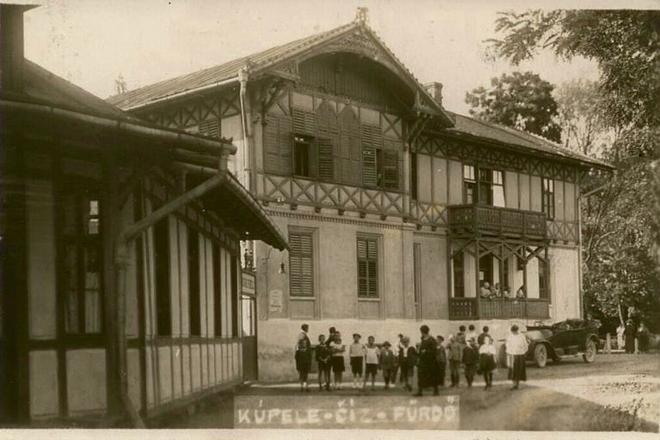This postcard dates back to around the 1920s and 1930s and depicts a group of child patients in front of a spa building. Many mineral springs have appeared in a similar way to the one in Číž. In 1862, local citizen András Hárnocz discovered salty water eight metres below the ground while digging a well on his land. Following this discovery, people from the municipality began to use the water for cooking as well as salt licks for animals.
Only three years later, following an analysis of the water conducted in Budapest, this salty water was found to contain healing elements, such as bromine and iodine. Encouraged by these findings, Artur Glos, a geologist and mining engineer from Číž, dug two more bores in the earth. He discovered that the water found at 35 metres below the earth´s surface contained a much higher content of iodine and bromine than that found nearer to the surface. It was in this way that the spring Hygiea originated, and its water has been used as oral treatment for over a century. The second spring was given the name Neptune, and together with the first discovered spring, is used as a bathing treatment.
The construction of the spa complex in Číž began in 1888 when The Rimamuráň Company purchased local plots of land on which to build spas, resulting in five spa buildings and two army boarding houses.
By the end of the 19th century, the spa offered its visitors numerous facilities, ranging from a tennis court and outdoor music performances, to ballroom evenings, a piano, daily newspapers and rowing and bathing in the Rimava River. In addition, the complex contained a post-office, telegram service, a telephone and a jewellery shop.
The unique water from Číž also garnered a reputation abroad; it received a certificate from a Brussels fair in 1870 and a silver medal from the World Expo in St. Louis in 1904. The water had been known in America even before this, as one-litre bottles used to be shipped there for sale as part of 25-bottle crates.
During the time of the first Czechoslovak Republic, a children´s sanatorium was founded in Číž, successfully healing damaged circulation and musculoskeletal systems, nervous conditions and metabolic illnesses. The sanatorium still operates today.


